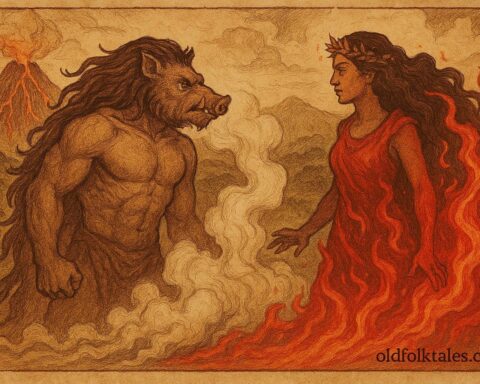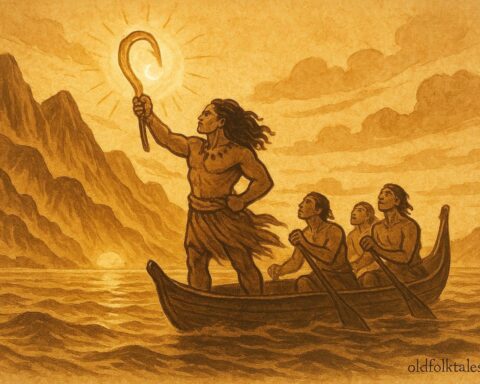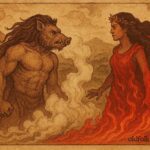Long ago, in the rich green lands of Aotearoa, where the mountains breathed mist and the waves whispered the names of ancestors, there lived a great chief named Kahungunu. He was known across the tribes not only for his striking presence and noble lineage but also for his intelligence, diplomacy, and courage. His mana (spiritual authority) was such that people said the winds bent around him in respect.
One day, Kahungunu heard tales of a woman whose beauty and grace were unlike any other, Rongomaiwahine, the chieftainess of the Mahia Peninsula. She was said to possess not only beauty but also wisdom and strength of heart. The elders called her ariki tapairu, a woman of the highest rank, descended from noble lines that reached back to the gods. Suitors had come from far and wide, yet none had won her hand.
When the stories of her reached Kahungunu, his heart stirred. But his interest was not only born of love or admiration. He saw in her the potential to unite two powerful lineages, to weave together the strength of his people with hers. In that union lay the promise of peace and prosperity. And so, with determination, Kahungunu resolved to win Rongomaiwahine’s heart, not by conquest, but by wisdom and humility.
The Journey to Mahia
Kahungunu began his journey southward. His canoe glided across calm waters, guided by stars that had long been his ancestors’ companions. Along the coast, villages welcomed him, for his name was well known. Wherever he stopped, people spoke of Rongomaiwahine, and each story deepened his resolve.
When he finally reached Mahia, he found the place guarded by tradition and pride. Rongomaiwahine’s people looked upon strangers with caution. They had seen many men arrive with gifts and boasts, only to be sent away. But Kahungunu was no ordinary man. He did not arrive with loud songs or grand promises; instead, he observed quietly, learning the customs of the people, the rhythm of their days, and the spirit of the land.
He noticed that the people respected those who contributed to daily life. So, instead of declaring himself a suitor, Kahungunu joined in the work, fishing, cooking, and helping with tasks that others might consider beneath a chief. When the tribe saw him, a man of rank and renown, humbly helping to prepare meals and mend nets, they whispered in surprise and admiration.
The Trials of Skill and Patience
Rongomaiwahine soon heard of this unusual man who carried himself with such quiet strength. Her curiosity piqued, she watched from a distance as Kahungunu helped her people. But her heart was not easily swayed. She decided to test him.
The first challenge came during a feast. Knowing that Kahungunu had a reputation for cleverness, Rongomaiwahine sent him a portion of food that was poorly cooked, to see if pride or anger would betray him. But Kahungunu received it with gratitude, eating calmly and praising the meal. His composure impressed her, a man who could control his temper was one who could lead wisely.
Next came a test of skill. Rongomaiwahine arranged a great fishing expedition. Her people were skilled in drawing the bounty of Tangaroa, the sea god, and she wished to see how this stranger fared. When the nets were cast, Kahungunu took command of a small group and guided them with keen precision. He read the tides and currents, and when the nets were drawn, his catch overflowed. The people cheered, and even Rongomaiwahine smiled quietly from the shore.
But the final trial was of endurance. The chief was invited to a grand feast in Rongomaiwahine’s honor, one filled with music, laughter, and competition. There, he was challenged to eat more than any other man, a test of both stamina and pride. Kahungunu accepted, knowing that to refuse would be to show weakness. With patience and strategy, he ate until his rivals could continue no longer. When the challenge ended, he did not boast; he simply stood and thanked his hosts, showing the dignity that marked a true leader.
The Winning of Rongomaiwahine’s Heart
As the days passed, Rongomaiwahine’s tests revealed more of Kahungunu’s character. He was strong, yet humble; wise, yet gentle. When he spoke, he did so with purpose, weaving words that honored both his lineage and hers. His understanding of the sacred balance between men and women, chiefs and people, nature and spirit, resonated deeply with her.
Eventually, she invited him to her home. There, beneath the evening stars, they spoke long into the night, of ancestors, of dreams, and of the future of their people. It was said that as they talked, the stars above seemed to move closer, as though the heavens themselves wished to listen.
Kahungunu did not ask for her hand directly. Instead, he declared his intention to stay, to serve her and her people until they saw him as one of their own. This act of humility broke the final barrier between them. Rongomaiwahine, moved by his sincerity, accepted him as her husband.
The Legacy of Their Union
Their marriage united powerful lines of ancestry, and from them descended the great tribe of Ngāti Kahungunu, one of the largest Māori iwi (tribes) in Aotearoa. Their story became a symbol of what could be achieved through patience, wisdom, and respect.
Generations later, their descendants would recall that it was not war or wealth that founded their tribe, but the joining of two hearts guided by intelligence and humility. The union of Kahungunu and Rongomaiwahine became a reminder that leadership was not measured only in power or strength, but in understanding and balance.
Even today, when the winds sweep across the Mahia Peninsula and the waves strike the shores, elders tell the story of how a chief won a chieftainess not through conquest, but through service and love.
Discover the adventures of Māui, Pele, and Tangaloa in the timeless Polynesian oral tradition
Moral Lesson
The story of Kahungunu and Rongomaiwahine teaches that true leadership lies in humility, respect, and patience. Strength alone does not win hearts or unite people, wisdom, empathy, and service do. Through their union, the Māori remind us that harmony is born from understanding, and love can be a force of creation as powerful as war or courage.
Knowledge Check (Q&A)
- Who were Kahungunu and Rongomaiwahine?
They were legendary Māori ancestors whose union founded the Ngāti Kahungunu tribe in Aotearoa (New Zealand). - What trials did Kahungunu face to win Rongomaiwahine’s love?
He faced tests of humility, skill, and endurance, including cooking, fishing, and feasting challenges. - What values does the story highlight?
The tale celebrates humility, patience, respect, and wisdom as marks of true leadership. - What is the significance of their union in Māori culture?
Their marriage symbolizes unity between tribes and the creation of Ngāti Kahungunu, one of the great Māori iwi. - How does Kahungunu demonstrate leadership?
Through service and restraint, he earns respect and love, embodying the qualities of a noble chief. - What moral lesson does this Māori folktale teach?
It teaches that love and leadership are strengthened by humility and understanding rather than pride or force.
Source: Adapted from The Ancient History of the Māori by John White (1887)
Cultural Origin: Māori (Aotearoa/New Zealand)












